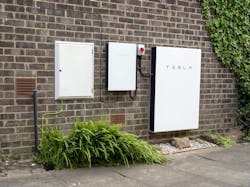Community Distributed Energy: Eaton, Tesla Teaming Up on Residential Solar-Storage Integration
Uniting to connect key generation elements in the residential microgrid future, power management firm Eaton and battery supplier Tesla are going to collaborate on streamlining the integration of home solar and energy storage systems.
The two companies announced the partnership on the first day of the RE+ conference in Anaheim, California. RE+ is one of the biggest energy transition-focused events in the industry, with more than 35,000 attendees last year in Las Vegas.
Tesla’s Powerwall battery system would work in tandem with Eaton’s new AbleEdge smart breakers with the goal of making solar-storage integration happen more quickly on the residential level. They hope to roll out the combination early in 2025.
A 2023 report by research firm Wood Mackenzie identified the residential microgrid market as expanding quickly within the on-site power sector. Demand from communities and residential developers was predicted to outpace the retail sector as a growth engine for microgrids, the report noted.
Five days ago, Eaton announced the AbleEdge home energy management system to support the firm’s Home as a Grid technology offering. The U.S. residential segment is expected to install 10 GW of battery storage capacity from this year through 2028, according to Wood Mackenzie.
“Until now, installing energy storage with load management was a complex and time-consuming process,” Paul Ryan, general manager for connected solutions and EV charging at Eaton, said in a statement. “By leveraging the joint expertise and expansive installed base of Eaton and Tesla, we’re planning to bring a solution to the mainstream market that utilizes dynamic, automated energy load management to intelligently extended available battery duration in an outage.”
Home battery storage systems can be utilized for backup power and, in service territories with virtual power plant capabilities, also used in grid services.
Nationwide, other projects and developers testing or utilizing residential-level battery storage have included West Point Military Academy, the Archer Green affordable housing development in New York city and a grid resiliency study by Duke Energy Florida.
“This collaboration will enhance what’s possible within the home energy ecosystem, allowing our customers to get even more value from their Powerwall and solar and furthering our mission to accelerate the world’s transition to sustainable energy,” James Bickford, director of global sales for residential energy products at Tesla, said.
The combined technologies also would work to strengthen cybersecurity protocols for connected devices, Tesla and Eaton say.
Tesla Powerwall batteries are included as part of several residential energy storage and microgrid developments planned across the country, although both of the following projects were announced two years ago. The planned Habitat Zero neighborhood being developed by Astreia is to be located in Brownsville, Texas, while developers on the all-electric Hillside East started construction last year in Vermont.
Follow Many Paths to Net Zero in the C&I Energy Transition
Subscribe to our free EnergyTech ENL
About the Author
Rod Walton, EnergyTech Managing Editor
Managing Editor
For EnergyTech editorial inquiries, please contact Managing Editor Rod Walton at [email protected].
Rod Walton has spent 17 years covering the energy industry as a newspaper and trade journalist. He formerly was energy writer and business editor at the Tulsa World. Later, he spent six years covering the electricity power sector for Pennwell and Clarion Events. He joined Endeavor and EnergyTech in November 2021.
Walton earned his Bachelors degree in journalism from the University of Oklahoma. His career stops include the Moore American, Bartlesville Examiner-Enterprise, Wagoner Tribune and Tulsa World.
EnergyTech is focused on the mission critical and large-scale energy users and their sustainability and resiliency goals. These include the commercial and industrial sectors, as well as the military, universities, data centers and microgrids. The C&I sectors together account for close to 30 percent of greenhouse gas emissions in the U.S.
He was named Managing Editor for Microgrid Knowledge and EnergyTech starting July 1, 2023
Many large-scale energy users such as Fortune 500 companies, and mission-critical users such as military bases, universities, healthcare facilities, public safety and data centers, shifting their energy priorities to reach net-zero carbon goals within the coming decades. These include plans for renewable energy power purchase agreements, but also on-site resiliency projects such as microgrids, combined heat and power, rooftop solar, energy storage, digitalization and building efficiency upgrades.

